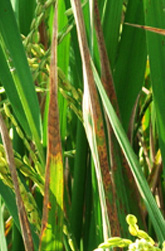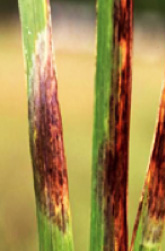Agricultural crops :: Cereals :: Rice
Leaf Scald:Microdochium oryzae
Symptoms:
- Zonate lesions of alternating light tan and dark brown starting from leaf tips or edges
- Lesions oblong with light brown halos in mature leaves
- Coalescing of lesions result in blighting of a large part of the leaf blade
- The affected areas dry out giving the leaf a scalded appearance
- Translucent leaf tips and margins
- Infected leaf tips also split near the midrib especially when there are strong wind.
|
| |
 |
|
 |
|
|
| |
ZONATE LEISONS |
|
OBLONG LEISONS |
|
|
|
Identification of pathogen:
- The conidia are borne on superficial stromata (compact masses of specialized vegetative hyphae) arising from lesions.
- They are bow to new-moon shaped, single-celled when young and 2-celled when mature, occasionally 2-3 septate.
- Asci are cylindrical to club-shaped and unitunicate (an ascus wherein both the inner and outer walls are more or less rigid and do not separate during spore ejection).
- The ascospores are fusoid (tapering towards each end) straight or somewhat curved, 3-5 septate.
|
Management:
- Avoid high use of fertilizer.
- Chemicals such as benomyl, carbendazim, quitozene and thiophanate-methyl can be used to treat the seeds to eliminate the disease.
- In the field, spraying of benomyl or fentin acetate or validamycin significantly reduce the incidence of leaf scald.
- Foliar application of captafol or mancozeb or copper oxychloride also reduces the incidence and severity of the fungal disease.
|
|


